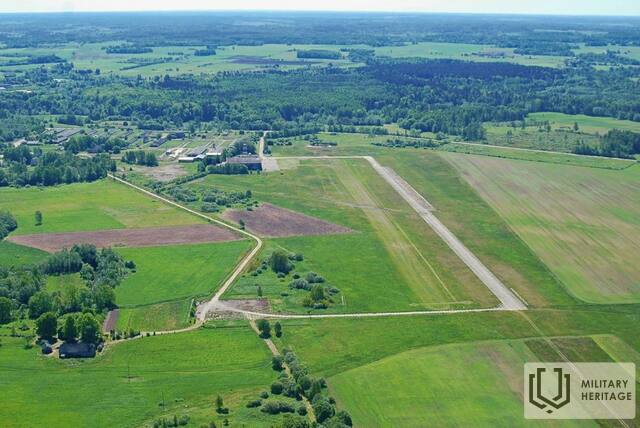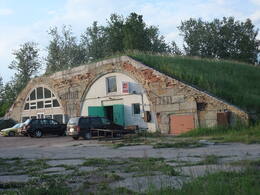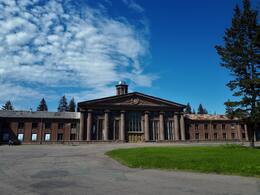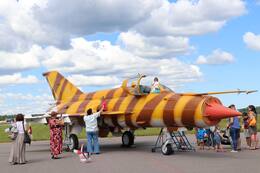The story of Cīrava airfield
Cīravas airfield – established during World War II, used as a DOSAAF airfield by the Soviets, currently used for agricultural purposes and recreational trips, and Soviet-era aircraft can be viewed in the hangar
Cīravas Airfield (ICAO: EVIA) is an uncertified airfield in Cīravas parish, Aizpute municipality. Built on the banks of the Durbe River, 2 km from the center of the village of Cīravas. The airfield has two runways: an 800 m long and 20 m wide concrete runway and a parallel 800 m long grass runway. According to the terms of the bases agreement, the USSR military contingent in Cīrava began construction of a military airfield in 1939. During World War II, the airfield was used by the German Luftwaffe until May 4-5, 1945.
After the end of the war, it was used as a DOSAAF airfield, where the Kurzeme Aviation Club named after Yuri Gagarin operated, whose activities were mostly related to gliding.
Nowadays, the airfield is used by the "Kurzemes Avioklubs" for recreational flights with motor gliders and parachuting lessons.
https://lv.wikipedia.org/wiki/C%C4%ABravas_lidlauks
Kurzemes Avioklubs – airfield, airplanes, gliders, flights, air shows, aviation (airclub.lv)
Related timeline
Related topics
Related objects
Vaiņode air base
Vaiņode airfield still has 16 Soviet-era aircraft hangars and an 1800 m section of the once 2500 m long runway. The airfield can only be visited with a previous booking. Vaiņode airfield was established during the Latvian independence as one of the cradles of Latvian aviation and was later one of the largest military airfields in the Baltic States. In 1916, two hangars for German Army airships were built. Airships were used to gather intelligence and bomb the positions of the Russian Army. Later the city of Riga bought the airship hangars and used their roof structures to build the pavilions of the Riga Central Market. In May 1940, the 31st Fast Bomber Aviation Regiment of the Red Army moved to Vaiņode, and the construction of a standardized concrete slab runway began. At the end of the summer of 1944 the partially completed airfield was used by various German aviation units, however, at the end of World War II, the same airfield was used by the Red Army aviation units fighting the German Army group called ‘Kurzeme’. After World War II the Soviet Air Forces were stationed in Vaiņode until 1992.
Rumbula Air Base
Located in the southeast of Riga, in Rumbula, between Maskavas Street and the Daugava River.
Rumbula was home to a Soviet Army Air Force airbase and a civilian airport alongside Riga's main airport in Spilve. Both airports existed until the opening of Riga Airport. Before World War II and the occupation of Latvia, Rumbula was home to an airfield for the Latvian Army Aviation Regiment.
After World War II, the Soviet Union began producing jet-powered aircraft, which required longer and smoother runways. Old airfields were expanded and new ones were built. The changing weather conditions in the Baltics and the short flight time of the first jet aircraft were the reason for the creation of many backup airfields. The noise of jet aircraft caused dissatisfaction among the residents of Riga, because the military airfield was located too close to residential areas and could create dangerous situations. In 1973, it was closed and the Lielvārde airfield was built in its place, to which combat aircraft were transferred. Shortly before the closure, an international scandal broke out. A US Air Force officer, who was one of the military attaches in Moscow, was beaten there. He was allegedly attacked by 14-20 airport employees who suspected that the airfield was being photographed.
Today, you can visit the abandoned airfield area.
Spilve airport
Located in Riga, Pārdaugava, in the Spilve meadows near Iļģuciems.
Spilve is famous in the history of military heritage for the grandiose Battle of Spilve in the 18th century and the Spilve airfield. Starting in the 20th century, it was used for testing aircraft, but during World War I it became a witness to the history of Latvian aviation.
During World War I, the Spilve meadows were used by the Russian army's air force for the purposes of fighting the German army. With the creation of Latvia, the airfield became the country's most important air force base and a training ground for pilots. The airfield's previous names were "Spilves Air Port" or "Riga Air Port", later "Riga Central Airport". It was the main airport in Latvia until the opening of the airport "Riga" in 1975.
Perhaps the Spilve airfield near Riga and the dream of reaching for the stars have contributed to the impressive achievements of many Latvian pilots. Perhaps, however, the beginning of Latvian aviation is much older and can be found in Priekule, where a Latvian blacksmith Zviedris made a flight from a church tower with a homemade device.
Today, the Spilve airfield is still in operation. You can see the airport building, built in 1954, which embodies the Soviet classicism or “Stalin Empire” style.
Sources:
Irbītis, K. Latvian aviation and its pioneers. Riga: Zinātne, 2004.
Brūvelis, E. History of Latvian Aviation: 1919-1940. Riga: Zinātne, 2003.
Official website of the state agency "Civil Aviation Agency". Available: https://www.caa.gov.lv/lv/latvijas-aviacijas-vesture-isuma [accessed 22.02.2021].
Aviation Museum “SKY ZOO”
The Aviation Museum “Sky Zoo” is located in Smārde parish, Tukums municipality, in the territory of Jūrmala Airport that was once the Tukums Military Airfield. The exhibit includes aircrafts YAK-40, AN-2, SU22M4, PZL TS-11 Iskra and a helicopter MI-24. Tour of the airfield includes hangars, caponiers and engineering equipment. The airfield was used by both the German and Soviet armies. During the Soviet occupation it was one of the most important military airfields in the territory of Latvia. The fighters stationed there were intended to attack enemy ships and bomb coastal fortifications. On the night of 9 November 1975, a battle alarm was received at the Tukums airfield – there was enemy warship in the territorial waters of the Soviet Union (in the Gulf of Riga), and it had to be destroyed. Several planes took off from Tukums. However, it turned out that it was the Soviet naval warship ‘Storozhevoi’ (Guardian) on which an armed mutiny against the existing Soviet regime took place. When the planes reached the warship, the battle was still ongoing. Later the rebel leader Valery Sablin, a Soviet naval officer, was wounded and the mutiny ended. He was sentenced to death for treason. This was one of the most dramatic events showing the discontent with the regime and marking the approach of its collapse.










